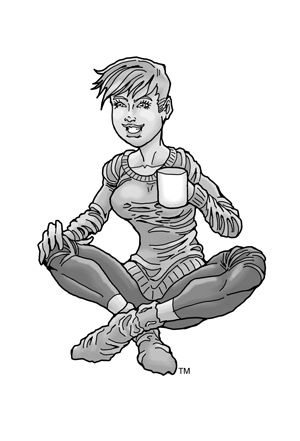In This Article, We'll Cover:
- What Causes Body Odor
- The History & Science of Deodorant
- Today’s Deodorant Problems
- Greenwashing in the Deodorant Industry
- 6 (Actually) Different Natural Deodorant Types & Why They Actually Work
- How i Healthy’s Favorite Natural Deodorants & Why
Another article about natural deodorant?
Really?
How many articles about natural deodorant have you read?
How many have you tried only to be disappointed?
You start your day feeling confident. Only to spend the rest of it self-conscious, arms pinned at your sides lest others get a pungent whiff.
It is a struggle.
I have tried many deodorants. I hoped each new one had something the others didn’t.
What I found was something else.
A quick scan of ingredients showed that most natural deodorants were the same.
The same underperforming elements. The same stinky results.
There has to be more than just another essential oil blend!
But rejoice, there are many to pick from! (And some to avoid).
By the end of this article, you’ll have several actually different deodorants to try.
Some might work for you, others not.
But that’s because we each experience body odor for different reasons.
These deodorants target the different reasons for odor.
Maybe it’s a vitamin difference or an imbalance of bacteria. Or maybe you need to increase the acidity of your armpits.
Let’s go back to basics and see body odor’s origin story.
Body Odor 101
Sweat by itself doesn’t have an odor. Body odor comes from bacteria that live in the moist places of our bodies. Staphylococci and Corynebacterium are common species of bacteria that live in the armpit. (30)
Body odor is the byproduct of bacteria chemically breaking down when combined with sweat. When Staphylococci breaks down it is smelly; Corynebacterium is even smellier. (28)
Odor is a combination of bacteria with sweat.
So, where does the sweat come from? The eccrine glands and apocrine glands.
Eccrine Glands
- Found almost everywhere on the body. The highest concentration is in the palms, soles, and
- Primary function is to regulate the body’s temperature.
- Produce sweat with a high salt content. This salty sweat is harder for bacteria to break down and thus less smelly.
- Shaped like coils and found in the deeper layers of the skin called the dermis. They empty into the ducts on the skin’s surface rather than into a hair follicle.
(30)
Apocrine Glands
- Activated during moments of emotional stress.
- Does not empty into ducts, but rather into a hair follicle.
- Dormant until puberty.
- Found in the underarm and groin area.
- High in protein. This protein becomes smelly when broken down by the bacteria that live on our skin.
- Not intended to regulate body temperature.
(30)
Deodorant: History & Today's Problems
The First Deodorants
Before we dive in to modern deodorants, let’s go back to roots of body odor cover-ups.
Scented oils and perfumes dominate the deodorant scene throughout history. But the Ancient Egyptians had a few more options:
- Deodorant “body rubs” from ostrich egg, tortoise shell, and roasted gallnut from tamarisk trees.
- Incense mixed with porridge and then applied as a pit paste.
- Ground carob powder applied to armpits for chocolatey undertones.
(19, 20)
Enter: Antiperspirants and Body Shaming
Deodorant, as an antiperspirant, is a modern invention from the early 1900’s.
First, there was antiperspirant cream. To keep his hands dry in the operating room, a surgeon concocted a cream that stopped sweat (for up to three days!) via an acid suspended aluminum chloride. (18)
His daughter, Edna Murphy, applied it on her armpits. The sweat-free result spurred attempts to market the cream. The antiperspirant deodorant “Odorono” was born. But the public wasn’t interested. Most people masked their funk with perfume and concealed sweat with “dress shields”. These cotton or rubber pads placed in the armpit absorbed perspiration, protecting fabric. Consumers saw perspiration as healthy, and questioned the safety of preventing it. (18)
It didn’t help that Odorono damaged skin and clothing too. (18)
Murphy hired James Young, a copyeditor, to market Odorono. And market they did. With gender-targeted advertising, perspiration was marketed as a social faux pas. (18)
James Young created a need. A need to be sweat-free. And sweat caused odor. If you smelled, according to Young’s marketing, no one would tell you, but everyone would know it and gossip about you. You would be unpopular and unable to attract or keep a man. The solution to the single life? Antiperspirant. (18)
Using gender-targeted shaming, advertisers profited from insecurities and scare tactics to push antiperspirant. (18)
One advertisement calls a fictitious Mary, “stupid”, for not releasing her body caused her loneliness. Another says a woman is “beautiful, but dumb” for not using antiperspirant. (18)
During the Great Depression, advertisements claimed body odor lead to unemployment. Antiperspirant meant job security. (18)
America was convinced sweating was bad. But no one would tell you that you smelled bad. The only way to avoid shame, gossip, and the single life was antiperspirant deodorant. Reapply, reapply, and reapply.
For decades. Until today.
The Dangers of Antiperspirant
Turns out, consumers in the early 1900s had the right gut feeling. Preventing sweat isn’t healthy.
Why?
Antiperspirant deodorants stop odor by plugging the armpit’s pores. This prevents the release of sweat. That ain’t good. We need to sweat!
Sweating is the body’s natural form of detoxing.
Toxins such as arsenic, cadmium, lead, and mercury excrete through sweating (1). If we block the exit route, our body could retain them instead.
Sorry, James Young, sweating isn’t a faux pas. It’s our bodies natural way of helping itself.
Plus, aluminum salts found in antiperspirants can kill off important species of bacteria in the armpit. This causes other species to overgrow. The worst part? Those overgrown species are the stinker bacteria. (17)
People use antiperspirant but end up stinker in the long run. This means folks use even more deodorant to combat the funk. Antiperspirant deodorant creates a dependency for antiperspirant.
Not only does this cycle or reapplying not work, it’s a money pit.
What About Rock Salt?
“But Artemis!” You might say, “what about crystal rock deodorants?”
Crystal deodorants often claim, “no aluminum chlorohydrate’” are “all natural”.
Not so fast.
Crystal deodorants often list “potassium alum” as an ingredient. Or the even more obscure “mineral salts”.
Mineral salts sound okay, ya? Like, I’d put that on a salad or something.
Don’t be fooled by Greenwashing Scams like I was.
Years ago, I bought a crystal deodorant. I thought I outsmarted my BO with the most natural solution there was. What’s more natural than a chunk of rock?
I was wrong.
Greenwashing Alert: “Mineral salts” is potassium alum. An abbreviation for potassium aluminum sulfate. (5)
That’s not aluminum free. Nice try. It’s still an antiperspirant blocking our body’s ability to sweat and detox.
Manufacturers claim potassium alum molecules can’t penetrate the skin. But research supporting this is limited. (5)
But wait! There’s More!
Deodorants might also have chemicals like:
- Parabens
- Propylene Glycol (PEG)
- Synthetic Fragrances and Phthalates
- Triclosan
(9, 10, 11, 12, 13)
The Chemicals Guide explores these in more detail.
Our skin needs specific bacteria to maintain a happy microbiome. These chemicals and aluminum salts can disrupt that balance.
Now, the reason why you are here: What different types of natural deodorants are there?
Note: After I discovered Lead Toxicity was the root cause of my body odor, and curated an Amazing Body Care Routine, I use less deodorant. With a happy pit-biome and body, I didn’t smell as bad. And dare I say, I didn’t need deodorant much. But I still use some deodorant.
6 Natural Deodorant Types
Before we dive into the six different types of deodorant, what else goes into consideration for a recommended brand?

The How i Healthy Standard
Our favorite products/brands meet as many of these conditions as possible.
Healthy body, healthy planet, & healthy sex means:
- Align with My Best Sustainability & Ethical Tips
- As Local as Possible
- Cruelty-Free
- Doesn’t Contain these Harmful Chemicals
- Environmental and/or Socially Responsible Company
- Ethically Made: Fair Trade, Living Wages, Safe Worker Conditions
- Gender-inclusive
- No Greenwashing Scams
- Organic & Sustainably Harvested Ingredients
- Pass How i Healthy’s Counterfeit Vetting Process
- Purchased Through/From an Ethical Shop/Marketplace.
- Zero Waste / Plastic & Bioplastic-free / Home Compostable
- 1% for the Planet®, B Corporation®, Green American Business®, or similar credentials
Additionally, the natural deodorant had to:
- Contain no antiperspirants or aluminum.
- Not stain clothing or cause yellowing of fabric.
- Work! No point in using deodorant if it doesn’t work.
Here’s what made the cut.
1. Oil/Butter, Drying Agent , & Scent
When you walk down the aisle of a store, most natural deodorants you see are this blend of ingredients. There is also a large selection of scents to pick from because of the variety of essential oils.
But at their core, they are all the same.
Coconut oil, beeswax, and shea butter are the base for the deodorant in the form of a stick or paste. Drying compounds, like arrowroot powder, pair with baking soda, an odor neutralizer.
Copy, paste. The same stuff remixed over & over.
This blend of ingredients, the most common for “natural” non-antiperspirant deodorants does nothing for me.
I can put on this natural deodorant all day long and still clear a room.
Plus, baking soda irritates the heck out of my pits.
I don’t have any brands I’d suggest with good conscience.
But there are plenty of people who do have great results with this basic option.
Check out Earth Hero®’s Deodorants for options like this.
2. Magnesium
Now here is a pretty thing!
Magnesium-based deodorant. Our body uses magnesium for hundreds of different functions. Magnesium deficiency causes issues, including body odor.
While magnesium-based deodorants alone are not enough for me personally, this might be a good option for you.
Here’s a few plastic-free & natural deodorants featuring magnesium:
3. Probiotic
These deodorants focus on bringing balance to the bacteria on the skin.
Much like probiotics for stomach, probiotics for the skin replenish good bacteria. The lack of bacteria (or imbalance caused by antiperspirant) can lead to dysbiosis, or imbalance, causing all sorts of issues. And, yep, you guessed it, body odor.
These deodorants boost the odorless bacteria to keep the stinker bacteria at bay.
4. Magnesium, Zinc Based, & Probiotic
Zinc, when used in deodorants, can inhibit growth of some bacteria strands, including staphylococcus, one of the stinky bacteria. (32, 33)
With less of those bacteria strands, less stinky ones can move in instead.
Here’s a natural deodorant (my favorite solid bar deodorant) that take the power of zinc and adds magnesium and probiotics to the mix:
Tierra and Lava
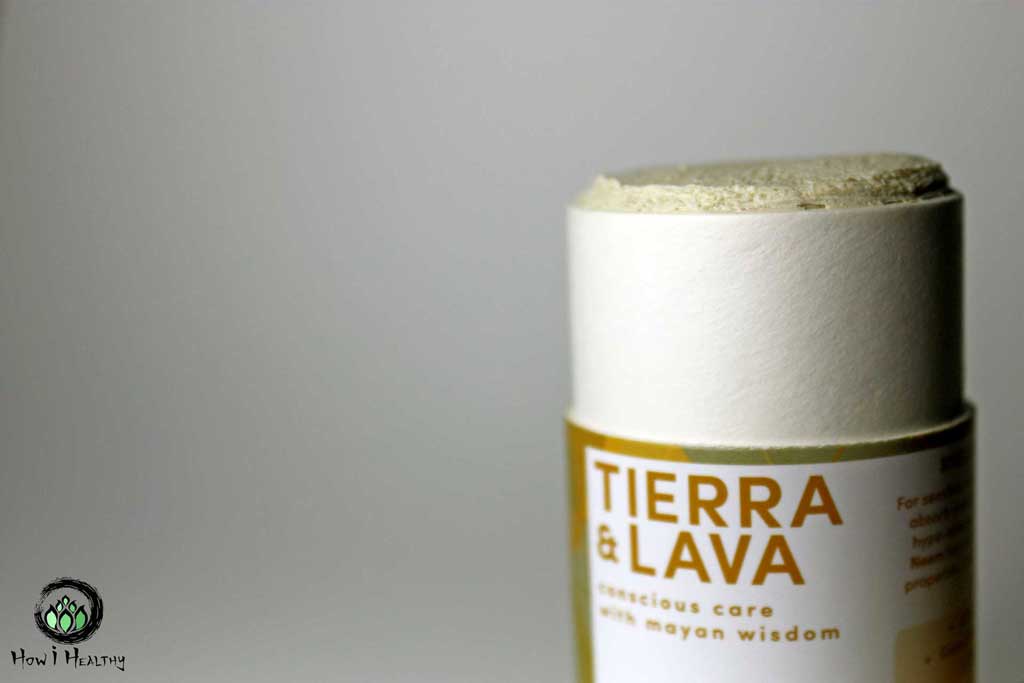
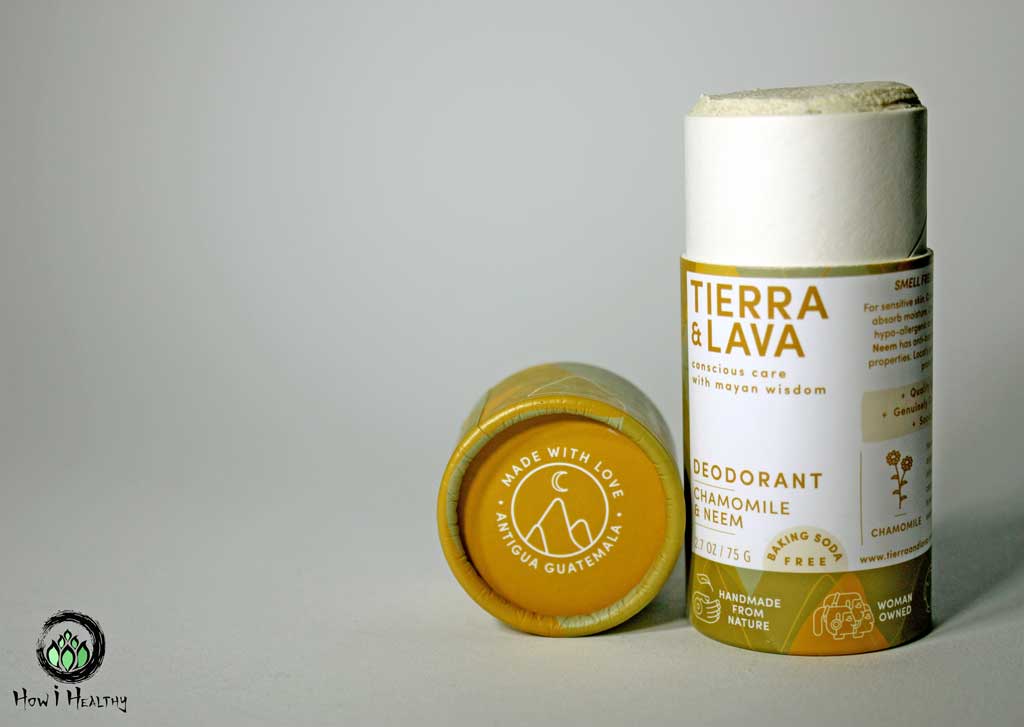


Product Kudos
Origin: Guatemala, Certified Fair Trade.
End of Life: Recycle or compost paper tube.
Ingredients/Packaging: Plastic-free paper tube.
Cocos Nucifera (coconut) Oil, Theobroma Cacao (cocoa butter) Seed Butter, Cera Alba (beeswax), Zinc Oxide, Magnesium Sulfate, Corn Starch Powder, Maranta Arundinacea (arrowroot) Root Powder, Ricinus Communis (castor) Seed oil, Copernicia Cerifera (carnauba) Wax, Lactobacillus Ferment, Lavandula Angustifolia (lavender) Flower Oil, Citrus Grandis (grapefruit) Seed Extract, Tocopherol, Melia Azadirachta (neem) Seed Oil.
Why It’s Awesome:
- Certified fair trade.
- Chamomile & Neem Deodorant has a delicate scent. It’s warm with subtle floral notes.
- Made without palm oil, baking soda, parabens, sulfates, phthalate, GMOs, or fragrances.
- Works pretty well! The powerful trifecta of magnesium, zinc oxide (non-nano), and probiotics (lactobacillus) means happy pits that don’t stink.
- For me it worked pretty well. But I prefer water-based deodorants over stick. So, my hunt continued!
(22, 25)
Company Kudos
- Awesome products, ethical practices, and stewardship. I’m in love.
- Lucy Ashman, the woman behind Tierra and Lava, combines traditional Mayan ingredients with botanicals from her organic garden to handcraft skincare products. (25)
- Lucy Ashan lives in Antigua, Guatemala and sources from her neighboring farms. Not just any farms. Don Eduardo and Don Rafa for artisan beeswax and honey. Don Max for Maayan black salt. Dominga Bo for copal, a tree resin. That’s some incredible traceability. (22)
- The Tierra & Lava blog! I enjoy the articles about ancient and modern Mayan culture.
- Uses a solar-powered server for the website, and conserve water with a compost toilet. It’s the little details that make me swoon.
5. Zinc, Silver, & Triethyl Citrate
These deodorants combine the odor-busting properties of zinc, silver, and triethyl citrate.
Silver, like zinc, has show to also reduce odor-causing bacteria. While triethyl citrate prevents the breakdown of sweat, which also prevents odor. (32, 33, 34, 35)
My favorite version of this natural deodorant is: Blissoma® Deodorant.
While found Tierra & Lava Chamomile & Neem effective, Blissoma® is water-based and doesn’t leave a residue on clothing.
Blissoma®
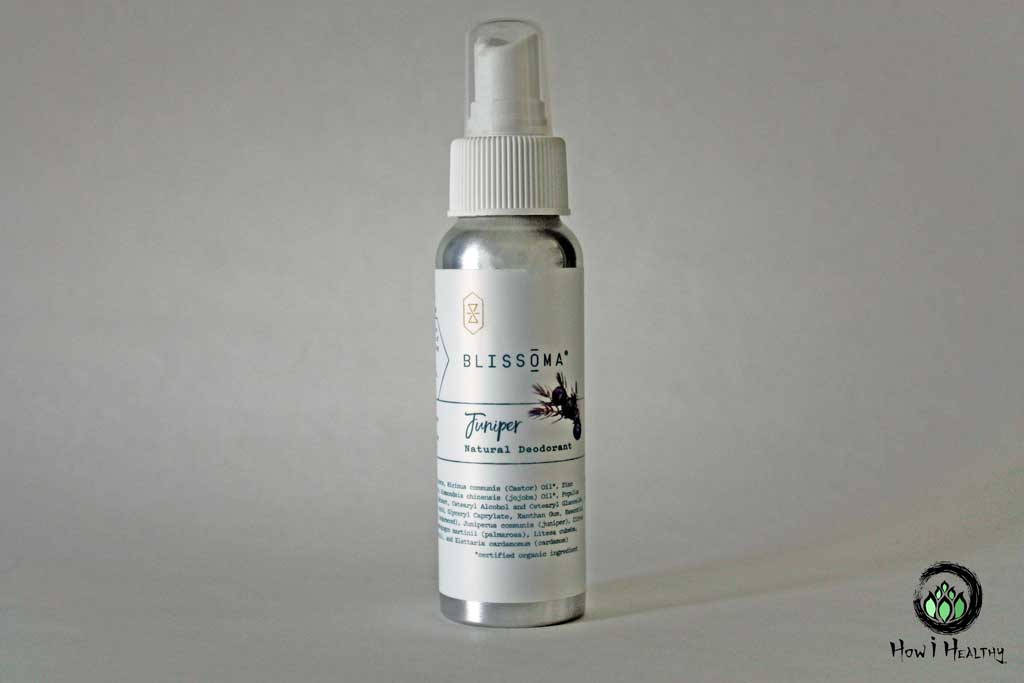

Product Kudos
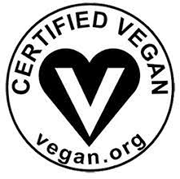




Origin: St. Louis, USA.
End of Life: Recyclable aluminum bottle.
Ingredients/Packaging: Aqua (Water), Triethyl Citrate, Ricinus communis (Castor) Oil*, Zinc Ricinoleate, Glycolic Acid, Simmondsia chinensis (jojoba) Oil*, Populus Tremuloides (Aspen) Bark Extract, Cetearyl Alcohol and Cetearyl Glucoside, Silver Citrate and Citric Acid, Glyceryl Caprylate, Xanthan Gum, Essential oils of Cedrus atlantica (cedarwood), Juniperus communis (juniper), Citrus reticulata (mandarin), Cymbopogon martinii (palmarosa), Litsea cubeba, Pogostemon cablin (patchouli), and Elettaria cardamomum (cardamom).
Why It’s Awesome:
- Biodegradable and plant-based.
- Palm-oil free.
- The scent! I love Juniper, but there’s also Citrus and Lavender.
- Water-based. No stains or white pits. Ever.
- Works! That’s because of the awesome combo of silver, zinc, and triethyl citrate. (32, 33, 34, 35)
- While I liked the results of this deodorant, and that it was water-based, I wanted a deodorant from a company with more ethical & sustainability certifications.
Company Kudos
- Donates regularly to local non-profits specializing in access to healthy lifestyles for underserved populations within their local community of St. Louis, MO.
- FSC® certified paper goods, plastic-free packaging.
- Leaping Bunny® and Vegan certified.
- Solar powdered facility.
- Sources from independent, regenerative, and organic farms.
6. Acid-Based: AHA
And my personal favorite. Even though I rocked Blissoma® for a while, I wanted a deodorant from a company with more ethical & sustainable certifications.
Enter: Nécessaire Deodorant.
This Acid-based deodorant lowers the pH of the armpits to inhibit bacteria growth. (39)
Bacteria don’t like acidic environments. So by making an armpit more acidic, less Bactria grows. Less bacteria growing means less bacteria breaking down. That means less stinky. (39)
What do we mean by acid?
In deodorant, that acid is typically Alpha Hydroxyl Acid (AHA). It goes by a few names; the two big ones are:
- Citric Acid: From fruits.
- Glycolic Acid: From sugarcane.
- Lactic acid: From sour milk.
- Mandelic Acid: From almonds, fruits, cocoa pods, or other foods.
(38)
AHA are used in many skincare and cosmetic products because of their ability to remove dead skin cells while invigorating new cell growth. (37)
There is data supporting that acidic environments inhibit odor-causing bacteria. But there is limited data that specifically uses AHA acids in deodorants to achieve an acidic environment. (40, 41)
Therefore, anecdotally, the Mandelic Acid-based Nécessaire Deodorant is the best deodorant I’ve tried.
There’s limited data to support my experience. All I can say is: It is the BEST natural deodorant I have ever used. Hands down. No contest.
Nécessaire
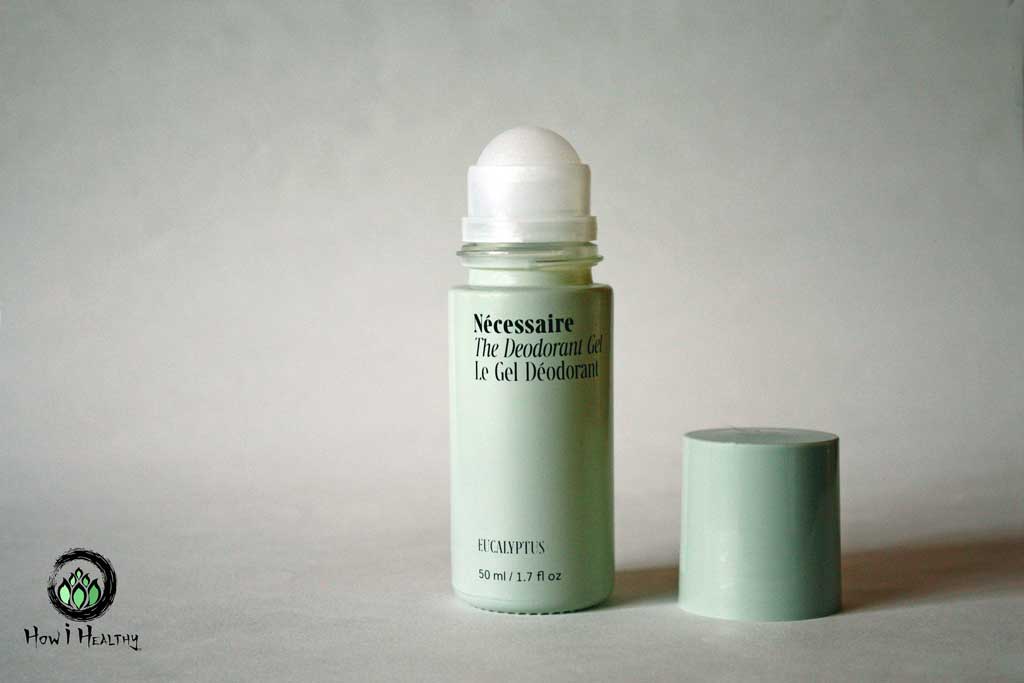

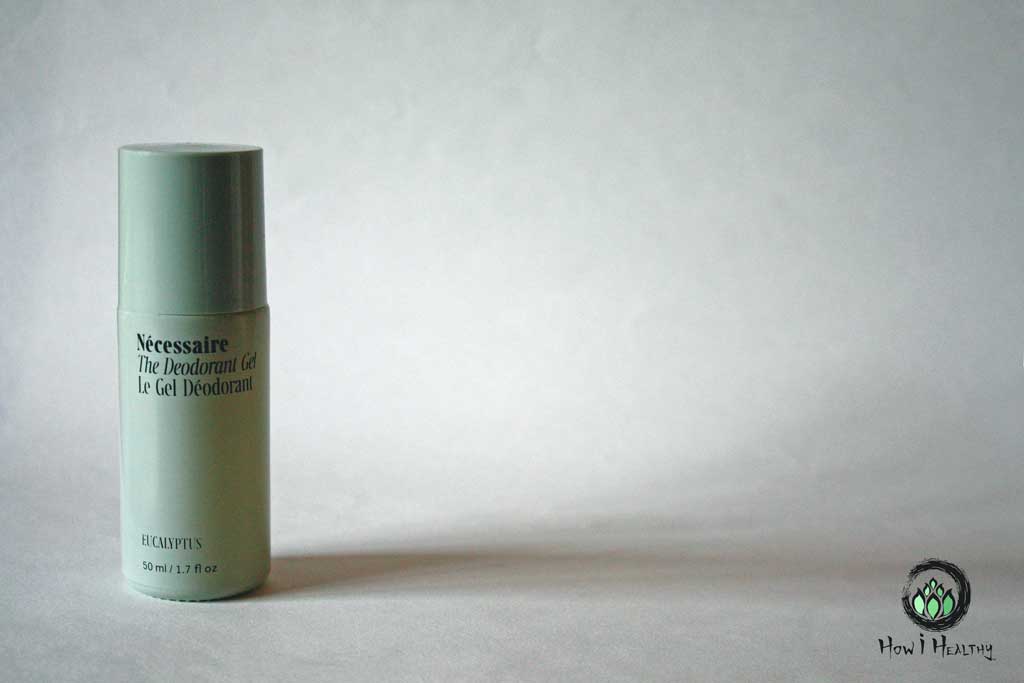

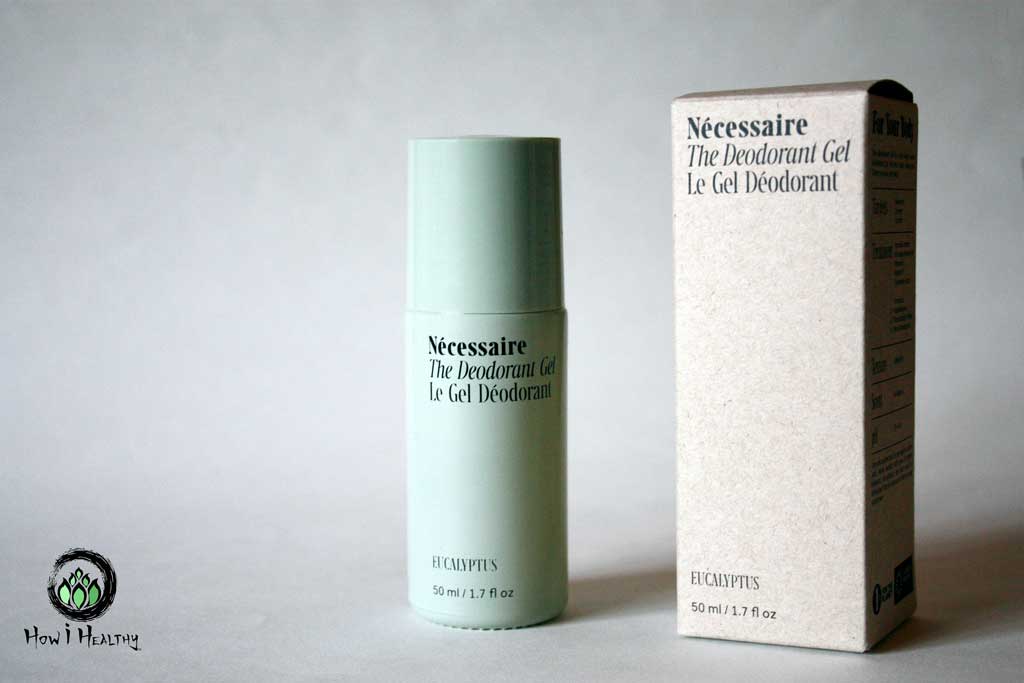



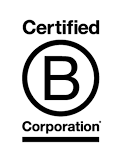






Product Kudos
Origin: USA.
End of Life: Recycle glass bottle, cap, and paper packaging.
Ingredients/Packaging:
- Nécessaire Deodorant: Water, Mandelic Acid, Caprylyl/Capryl Glucoside, Potassium Hydroxide, Hamamelis Virginiana (Witch Hazel) Water, Hydroxypropyl Methylcellulose, Gluconolactone, Lactic Acid, Panthenol, Niacinamide, Glycerin, Chamomilla Recutita (Matricaria) Flower Extract, Sodium Benzoate, Calcium Gluconate, Sodium Phytate, Benzoic Acid, Limonene, Linalool, Natural Oils for scents.
FSC® certified paper packaging. Glass bottle, plastic cap, & plastic roll-on applicator.
Why It’s Awesome:
- Clear and quick drying gel that rolls on easily.
- No baking soda, aluminum, PEGs, synthetic fragrance, parabens.
- The scent! I love Sandalwood, there is also Unscented if that is your jam.
- Palm-oil free.
- Water-based. No stains or white pits. Ever.
- Works! By creating a slightly acidic environment in the arm pit (3.5-4.5 pH), odor-causing bacteria can’t thrive.
Company Kudos
- 1% For the Planet® member and a Certified B-Corp®
- Climate Neutral® and Plastic Neutral® certified.
- Leaping Bunny® and Vegan certified.
- Creates formulas following EU standards and without EU’s prohibited substances list (Regulation No.1223/2009, Annex II).
- Made in the USA!
- FSC® certified paper goods, plastic-free packaging.
(42)
The Takeaway Message
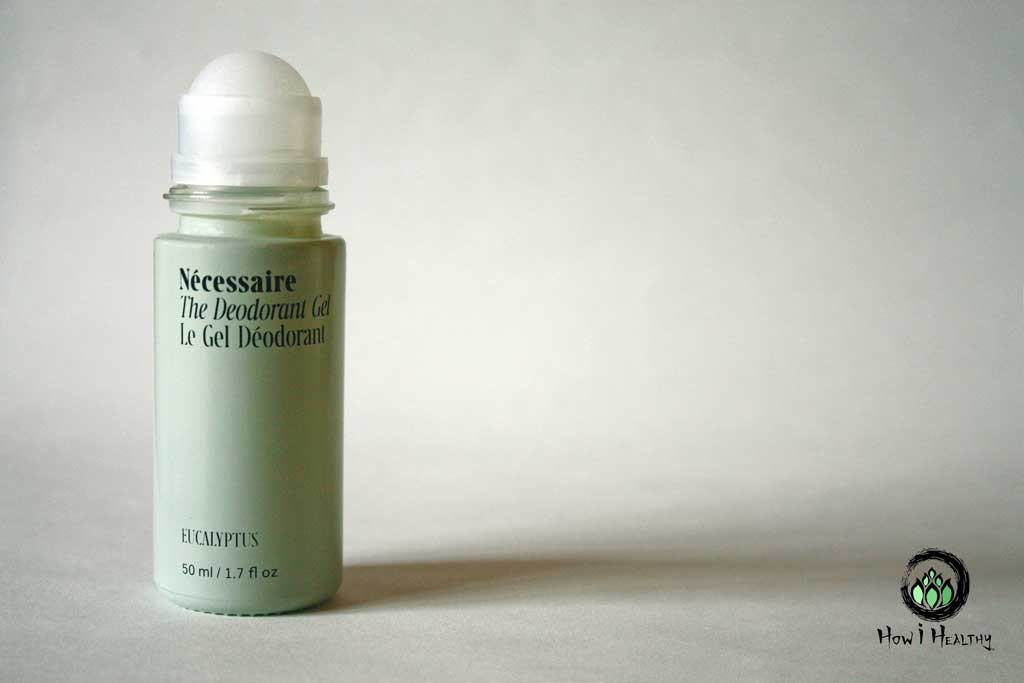






Many natural deodorants are just the same base ingredients with a slight twist.
Think: coconut oil, shea butter, arrow root powder, baking soda, and essential oils.
This often means that if that base doesn’t work for you, others like it won’t work either.
I’m one of those people who cannot get away with basic natural deodorant.
So I hunted for deodorants that went beyond the basics. And I found several.
Some worked better for me than others, but I list them out anyway because we are all different.
Maybe they will work for you.
Oil/Wax/Butter, Drying Agent , & Essential Oil-Based Natural Deodorants
There are none I recommend because every kind I’ve ever tried performed so poorly for me.
Maybe you are one of those folks who can get by. If so, check out Earth Hero®’s Deodorants, for some ethical & plastic-free options.
Magnesium-Based Natural Deodorants
Probiotic-Based Natural Deodorants
Magnesium, Zinc Based, & Probiotic-Based Natural Deodorants
Zinc, Silver, & Triethyl Citrate-Based Natural Deodorants
Alpha Hydroxyl Acid (AHA)-Based Natural Deodorants
- Nécessaire Deodorant (My top pick. Seriously, this stuff is good. It’s water-based, leaves no residue on clothes, and actually works.)
Want more natural sustainable & ethical body care products?
Check out My Favorite Skin, Hair, & Body Care for more water-free, plastic-free, sustainable, and natural options!
That’s How i Healthy!
-Artemis
- Sears, Margaret E, et al. “Arsenic, Cadmium, Lead, and Mercury in Sweat: a Systematic Review.” Journal of Environmental and Public Health, Hindawi Publishing Corporation, 2012, www.ncbi.nlm.nih.gov/pmc/articles/PMC3312275/
- “Aluminum.” National Center for Biotechnology Information. PubChem Compound Database, U.S. National Library of Medicine, https://pubchem.ncbi.nlm.nih.gov/compound/Aluminum#section=Metabolite-Description
- McGrath, K G. “An Earlier Age of Breast Cancer Diagnosis Related to More Frequent Use of Antiperspirants/Deodorants and Underarm Shaving.” European Journal of Cancer Prevention : the Official Journal of the European Cancer Prevention Organisation (ECP), U.S. National Library of Medicine, Dec. 2003, www.ncbi.nlm.nih.gov/pubmed/14639125
- Sim, Wilson, et al. “Antimicrobial Silver in Medicinal and Consumer Applications: A Patent Review of the Past Decade (2007⁻2017).” Antibiotics (Basel, Switzerland), MDPI, 26 Oct. 2018, www.ncbi.nlm.nih.gov/pmc/articles/PMC6315945/
- “POTASSIUM ALUM.” EWG, www.ewg.org/skindeep/ingredient/705178/POTASSIUM_ALUM/#.WirqskriY2w
- Knez Hrnčič, Maša et al. “Hop Compounds: Extraction Techniques, Chemical Analyses, Antioxidative, Antimicrobial, and Anticarcinogenic Effects.” Nutrients vol. 11,2 257. 24 Jan. 2019, doi:10.3390/nu11020257. https://www.mdpi.com/2072-6643/11/2/257
- “2.4.3.3.1 A Deodorant That Works.” Cosmetic Science and Technology: Theoretical Principles and Applications, by Kazutami Sakamoto, Elsevier, 2017, pp. 33–33.
- Tonoike, Mitsuo. “Smelling ‘Zuko’: Incense Rubbing into Hands and Smelling the Hands Activates Specific Brain Areas.” Dysfunction of Olfactory System [Working Title], 2019, doi:10.5772/intechopen.88987. https://www.researchgate.net/publication/336518282_Smelling_Zuko_incense_rubbing_into_hands_and_smelling_the_hands_activates_specific_brain_areas
- Dinwiddie, Michael T et al. “Recent evidence regarding triclosan and cancer risk.” International journal of environmental research and public health vol. 11,2 2209-17. 21 Feb. 2014, doi:10.3390/ijerph110202209. https://pubmed.ncbi.nlm.nih.gov/24566048/
- Bouslimani, Amina et al. “The impact of skin care products on skin chemistry and microbiome dynamics.” BMC biology vol. 17,1 47. 12 Jun. 2019, doi:10.1186/s12915-019-0660-6. https://bmcbiol.biomedcentral.com/articles/10.1186/s12915-019-0660-6
- Sato, Yoshiki et al. Yakugaku zasshi : Journal of the Pharmaceutical Society of Japan vol. 135,4 (2015): 631-42. doi:10.1248/yakushi.14-00193. https://pubmed.ncbi.nlm.nih.gov/25832843/
- Parlett, Lauren E et al. “Women’s exposure to phthalates in relation to use of personal care products.” Journal of exposure science & environmental epidemiology vol. 23,2 (2013): 197-206. doi:10.1038/jes.2012.105. https://pubmed.ncbi.nlm.nih.gov/23168567/
- Jang, Hyun-Jun et al. “Safety Evaluation of Polyethylene Glycol (PEG) Compounds for Cosmetic Use.” Toxicological research vol. 31,2 (2015): 105-36. doi:10.5487/TR.2015.31.2.105. https://pubmed.ncbi.nlm.nih.gov/26191379/
- Blissoma, “Junipur – All-Natural, Aluminum-Free, Deodorant. https://blissoma.com/juniper-natural-deodorant-aromatic-spray/
- “OUR VALUES.” Meow Meow Tweet, meowmeowtweet.com/pages/our-values.
- “Rose Geranium & Jasmine Deodorant.” All Good Products, 23 Mar. 2021, allgoodproducts.com/shop/deodorants/all-good-deodorant-rose-geranium-jasmine-2-5-oz/.
- Callewaert, Chris, et al. “Deodorants and Antiperspirants Affect the Axillary Bacterial Community.” SpringerLink, Springer Berlin Heidelberg, 31 July 2014, https://link.springer.com/article/10.1007/s00403-014-1487-1
- Everts, Sarah. “How Advertisers Convinced Americans they Smelled Bad” Smithsonian. August, 2 2012. https://www.smithsonianmag.com/history/how-advertisers-convinced-americans-they-smelled-bad-12552404/
- “6 Deodorant Ingredients.” Antiperspirants and Deodorants, by Karl Laden, 2nd ed., Marcel Dekker, 1999, pp. 169–170.
- “Perfume and Cosmetics.” Empire of Ancient Egypt, by Wendy Christensen, Chelsea House, 2009, p. 41.
- “Commitment”. All Good Product. com/our-story/commitment/
- “Meet Our Farmers.” TIERRA & LAVA, www.tierraandlava.com/farmers.
- “Chamomile & Neem Deodorant.” TIERRA & LAVA, www.tierraandlava.com/shop/chamomile-neem-deodorant.
- “Our Story & Social Responsibility.” All Good Products, allgoodproducts.com/our-story/.
- “Our Story.” TIERRA & LAVA, www.tierraandlava.com/ourstory.
- “What It Takes: Paper Tubes.” Meow Meow Tweet, meowmeowtweet.com/blogs/blog/what-it-takes-paper-tubes.
- “OUR FOUNDERS.” Meow Meow Tweet, meowmeowtweet.com/pages/our-founders.
- Kim, MJ., Tagele, S.B., Jo, H. et al. Effect of a bioconverted product of Lotus corniculatus seed on the axillary microbiome and body odor. Sci Rep 11, 10138 (2021). https://www.nature.com/articles/s41598-021-89606-5. https://www.nature.com/articles/s41598-021-89606-5
- Hodge, Bonnie D. “Anatomy, Skin Sweat Glands.” StatPearls [Internet]., U.S. National Library of Medicine, 5 Apr. 2019, www.ncbi.nlm.nih.gov/books/NBK482278/
- Lam, Tze Hau et al. “Understanding the microbial basis of body odor in pre-pubescent children and teenagers.” Microbiome vol. 6,1 213. 29 Nov. 2018, doi:10.1186/s40168-018-0588-z. https://microbiomejournal.biomedcentral.com/articles/10.1186/s40168-018-0588-z
- KANDA,, FUJIHIRO, et al. “Development of a Novel Hybrid Powder Formulated to Quench Body Odo.” j. Soc. Cosmet. Chem., 40, 335-346 , Shiseido Research Center, 1989, https://www.researchgate.net/publication/237438186_Development_of_a_novel_hybrid_powder_formulated_to_quench_body_odor
- Yousef, Jehad, and Enas N. Danial. “In Vitro Antibacterial Activity and Minimum Inhibitory Concentration of Zinc Oxide and Nano-Particle Zinc Oxide Against Pathogenic Strains.” International JOURNAL OF HEALTH SCIENCE, vol. 2, no. 4, 2012, doi:10.5923/j.health.20120204.04. http://article.sapub.org/10.5923.j.health.20120204.04.html
- S. Atmaca, K. Gül, R. Çiçek. The effect of zinc on microbial growth. Turk. J. Med. Sci., 28 (1998), pp. 595-597. https://journals.tubitak.gov.tr/cgi/viewcontent.cgi?article=4856&context=medical
- Nakane, T et al. “New antiaxillary odour deodorant made with antimicrobial Ag-zeolite (silver-exchanged zeolite).” International journal of cosmetic science vol. 28,4 (2006): 299-309. doi:10.1111/j.1467-2494.2006.00322.x. https://pubmed.ncbi.nlm.nih.gov/18489270/
- National Center for Biotechnology Information. “PubChem Compound Summary for CID 6506, Triethyl citrate” PubChem, https://pubchem.ncbi.nlm.nih.gov/compound/Triethyl-citrate
- “About.” Blissoma Botanical Beauty, https://blissoma.com/about-blissoma/.
- Tran, Diana et al. “An antiaging skin care system containing alpha hydroxy acids and vitamins improves the biomechanical parameters of facial skin.” Clinical, cosmetic and investigational dermatology 8 9-17. 19 Dec. 2014, doi:10.2147/CCID.S75439. https://www.ncbi.nlm.nih.gov/pmc/articles/PMC4277239/
- Tang, Sheau-Chung, and Jen-Hung Yang. “Dual Effects of Alpha-Hydroxy Acids on the Skin.” Molecules (Basel, Switzerland) 23,4 863. 10 Apr. 2018, doi:10.3390/molecules23040863. https://www.ncbi.nlm.nih.gov/pmc/articles/PMC6017965/
- Stenzaly-Achtert, S. et al. “Axillary pH and influence of deodorants.” Skin research and technology : official journal of International Society for Bioengineering and the Skin (ISBS) [and] International Society for Digital Imaging of Skin (ISDIS) [and] International Society for Skin Imaging (ISSI) 6,2 (2000): 87-91. doi:10.1034/j.1600-0846.2000.006002087.x. https://pubmed.ncbi.nlm.nih.gov/11428948/#:~:text=The%20Deodorant%20Roll%2Don%20induced,Cream%20from%206.2%20to%205.3.
- Dumas, Elizabeth R et al. “Deodorant effects of a supercritical hops extract: antibacterial activity against Corynebacterium xerosis and Staphylococcus epidermidis and efficacy testing of a hops/zinc ricinoleate stick in humans through the sensory evaluation of axillary deodorancy.” Journal of cosmetic dermatology 8,3 (2009): 197-204. doi:10.1111/j.1473-2165.2009.00449.x. https://pubmed.ncbi.nlm.nih.gov/19735518/
- Yoshioka, N et al. “Body odour aldehyde reduction by acetic acid bacterial extract including enzymes: alcohol dehydrogenase and aldehyde dehydrogenase.” International journal of cosmetic science 40,4 (2018): 425-428. doi:10.1111/ics.12473. https://pubmed.ncbi.nlm.nih.gov/29897105/
- “Footprint” https://necessaire.com/pages/footprint
Want More?
Want a deeper dive into microbiome science and skin care industry problems? Curious about historical hygiene? Like supporting local bookstores?
These books are excellent reads:
Clean: The New Science of Skin
By James Hamblin, M.D.
Here’s a dive into microbiome science, hygiene history, and the skin care industry. With a good side of humor thrown in too. Not a heavy academic read, but still full of good research-backed nuggets and history. Plus, practical ways to spot bogus claims and avoid skincare consumer traps.
This book developed my consumer skepticism for most products. A trait that has saved me money over the years.
Buy at: Bookshop® or Better World Books®
The Dirt on Clean: An Unsanitized History
By Katherine Ashenburg
For the Western history of hygiene, this is your book. It’s full of bathing practices, cultural perspectives on hygiene, and the questionable science that influenced it all.
Why were clean linens better than bathing? Why was good hygiene unpatriotic? How did politics influence bathing throughout the centuries? Just how did folks back in the day smell? Why were cold baths better than hot? And how did advertisements fuel body-shaming and cultural perceptions of hygiene? What’s the future of bathing?
Buy at: Bookshop® or Better World Books®


